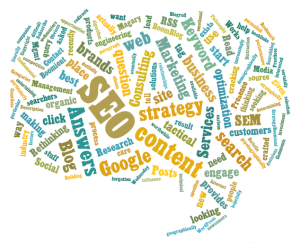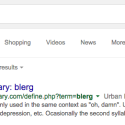 Businesses who engage customers on the web are using SEO and SEM more every day, as traffic driven through search is an increasingly vital source that companies and brands need to stay competitive.
Businesses who engage customers on the web are using SEO and SEM more every day, as traffic driven through search is an increasingly vital source that companies and brands need to stay competitive.
While most search spending is still on the $20+ billion dollar pay-per-click side of the industry, many businesses also invest in organic search optimization, which is the source of far more interested clicks than what paid ads can deliver. In this area, content quality is increasingly important in attracting visitors from search engines.
As newcomers learn about SEO, they can become quickly mired in both the technical and the tactical… getting ranked highly in Google might appear to a problem best solved by reverse-engineering Google’s secret algorithm, and determining the influence of various factors on the performance of a site.
While “cracking the code” of Google is a certainly a worthwhile endeavor (and a global industry), it’s actually not the place you want to start when thinking about SEO. I always tell my clients that SEO should be treated as part of a content strategy, first and foremost. Any business that is using the web to engage with people should already have a robust strategy for content, even if they haven’t done any SEO or PPC.
That broader strategy needs to be properly crafted, not around tactical specifics such as keyword selection, meta tags, redirects, or backlinks, but around the idea that their site provides ANSWERS to people seeking questions. Many marketers look to organic SEO as something that will help them convince Google that they are the best result for a given query. Instead, their focus should be on making sure that their site ACTUALLY IS the best result for a given query.
It’s About Answers
Searchers are not looking for keywords, really… those are simply the tools available to them via the use of a search engine. What they want are the answers that hopefully exist on the other end of the click, and every search is a question, even if the syntax isn’t organized that way.
Countless webmasters have dutifully placed a particular keyword in the Title tag, Description tag, and in every paragraph of their content, but in their optimizing zeal, have somehow forgotten to ANSWER THE QUESTION.
Some content-makers, like the so-called “content farms” that Google has recently cracked down on, don’t particularly care to answer the question, or not very well anyway, as long as they can get you to the page.
The growing volume of useless-but-optimized content on the web makes SEO difficult, but also opens up opportunities for marketers willing to think strategically about providing answers to searchers. Those who craft their content to offer real solutions, in a way that is engaging, entertaining, and finds a way to tell stories about their brands, will eventually do better in search, and deepen relationships with customers in the process.
So the next time you are doing a new web campaign, or looking to increase views to your site, put aside your SEO Optimization manual and start from scratch. Who is the ideal audience, and how can you help them?
Start with the easy stuff, where data exists… who are your customers, demographically, geographically, psychographically, etc. Then ask, “What do they care about? What are they emotional about? What are they seeking?” Not literally, in terms of search phrases, but in reality.. what is the unmet need that your business can fulfill? What does your product or service DO that provides a solution?
Answering these questions for your business or brand may lead you to content decisions that you may not have made if you only asked “how do I get Google to notice me?“. It may even lead to more fundamental issues about your marketing strategy, or the nature of your brands and products themselves.
So don’t put SEO/SEM in a “tactical” box. It’s part of your content strategy, which itself is part of a larger customer engagement strategy and brand strategy that every business and brand should have in place. Start there, and the tactical stuff will fall into place with greater ease.










